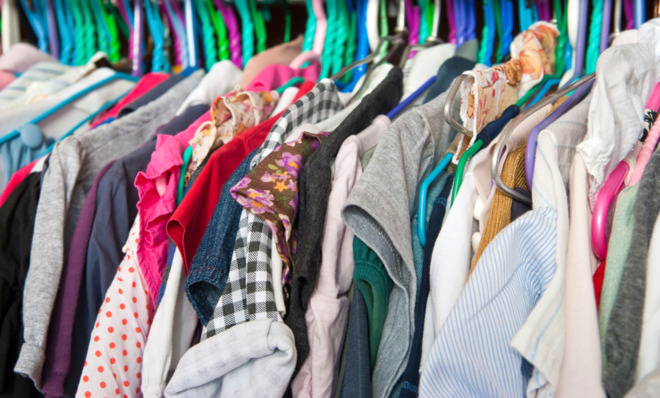7 steps to cleaning even the most cluttered closet
Most people wear just 20 percent of their wardrobe 80 percent of the time. It's time to let go.


April showers bring May flowers — and plenty of rainy days spent indoors. What better way to channel your drizzly weather restlessness than to tackle some much-needed spring cleaning? After all, there's nothing like being forced to stare at your own clutter to spur you into action.
One of the toughest organizational projects is, of course, your closet. Whether you're working with a small space, funky layout or too many items you swear you'll wear someday, figuring out what to keep, what to toss, and what to buy more of is a challenge many would prefer to forgo altogether.
And not only can it clear mental space, cleaning your closet can lead to tax write-offs — and perhaps even a profit. "Unclutter" maven Donna Smallin Kuper, professional organizer and author of How to Declutter and Make Money Now, points out that most people wear just 20 percent of their wardrobe 80 percent of the time, and letting go of those unworn, ill-fitting, or misguided items may be easier than you think — if you commit to trying.
The Week
Escape your echo chamber. Get the facts behind the news, plus analysis from multiple perspectives.

Sign up for The Week's Free Newsletters
From our morning news briefing to a weekly Good News Newsletter, get the best of The Week delivered directly to your inbox.
From our morning news briefing to a weekly Good News Newsletter, get the best of The Week delivered directly to your inbox.
Ready to free up space? Here are seven tricks that may clean your clutter, clear your mind, and, perhaps, pad your wallet in the process.
1. Grade your closet on a curve
The first step toward a clutter-free closet filled with clothes you love is to try everything on, says David Zyla, Emmy award-winning stylist and author of Color Your Style. This will help you analyze how you look in the garment, not just how it looks on the hanger. "Do the color, fabric, and cut express your authentic self? Would you rank this as an 'A+ look?'" Zyla asks.
Here's how to go about The Great Try-On: Consider each item, placing A+ looks on the left side of your closet. Then, for the next week, dress from the left side of your closet to determine what you truly love. "When you wear those items, do you get more compliments from your friends? A different type of romantic attention? More respect at work? Do you feel more confident? The ultimate goal is that eventually everything in your closet ranks an A+," says Zyla.
A free daily email with the biggest news stories of the day – and the best features from TheWeek.com
2. Place like with like
Now that you know which types of clothing flatter you and make you feel your best, it's time to take inventory of exactly what you have. Virginia Underwood, a professional organizer based in Hilton Head, S.C., suggests placing "like with like" to take stock of your inventory. "Put all pants together, all tops together, all dresses together, and then in order of color, light to dark," she says.
Then, create best-of lists for each category of clothing. "Pick your top 10 of each item — pants, tops, skirts, dresses," says professional organizer Jill Pollack. "You probably will never wear the rest. Be honest and let them go."
3. Shop your closet
As you categorize your clothing options, discover new possibilities, Underwood advises. "Check that you have a top that goes with each of your basic bottoms, in terms of color, pattern, sleeve length, weight," she says. "Pants and skirts that have up to five or six top options are giving you the best bang for the buck. Look for new ways to match your items and make what you already have look new and fresh."
If you notice you're lacking some staples — like button-down shirts or basic tees — make a note of what you need more of to complete your wardrobe. (More on this later.)
4. Determine what should go
At this point, you know which items you wear most often and feel confident in. Everything else can be broken down into two categories: monetary and sentimental.
For items in the "monetary" category — which include expensive purchases you never wear or use — Zyla encourages you to reframe your attachment: "You're not getting any use-value out of letting the expensive item hang in your closet, and you're actually creating negative use-value by wearing it when it doesn't suit you." Give yourself permission to get rid of these items — and if they really were that expensive, perhaps sell them for profit on eBay or at your local consignment store.
Items you're emotionally attached to (those in the sentimental category) can be even harder to get rid of — like that now-ratty tee commemorating your high school reunion or your mother's shiftdress from 1970. But it's important to realize that, at least when it comes to your daily wardrobe, these items don't hold value. "You do not have to get rid of them, but please don't leave them in your closet," Zyla says. "Create a memory box or find a storage closet with an extra shelf and store your memory clothing there, the way you keep other kinds of souvenirs."
Another good rule of thumb for knowing what to toss? "If you haven't worn something in three years, get rid of it, unless it is a wedding dress, a ball gown, or your most favorite pair of leather pants ever — but you currently live in the tropics," says Pollack. If you have any stained items you can't get clean, get rid of those, too, while you're at it.
5. Reap your profit
And now it's time to see if you can cash in on all your hard work.
For pricey, barely worn or vintage pieces, selling on consignment is a great way to earn some income for your discards. "To maximize your earnings, items should be like new, still in style, or a classic style, and clothing should be clean and pressed on hangers," Kuper says. A consignment store will likely sell clothing for about 20 percent to 35 percent of the original value (the higher end being for designer brands), she says, and you can expect to bank about 40 percent to 50 percent of that price.
Kuper recommends Klury.com, an online store for designer duds, because they send prepaid shipping labels and pay quickly. A few others to try? Liketwice.com, a reseller that accepts high-end brands like J.Crew and Ann Taylor; Tradesy.com, where you can set your own prices for clothing, accessories, and even wedding decorations; or Swapstyle.com, where you can trade with other users.
For those items you don't sell, donate — and reap the tax rewards when you itemize your deductions next year. (But make sure you're giving to an IRS-qualified charitable organization.) If your donation haul totals less than $500, just hang on to your receipt as proof of value. If you're feeling extra generous (or haven't cleaned out your closet in a very long time) and your contributions exceed $500, you'll be required to submit additional documentation come tax time.
6. Raise your bar … literally
Now that you've uncluttered, it's time to restructure your closet to maximize the space. Kuper suggests raising your clothing rod (and, thus, your clothing) higher so you have more room on the floor for a dresser, or adding a second rod to create double the hanging space. You can also lay a flat piece of wood across two or three tension rods at the top of your closet to create a shelf that will support bins for storing lesser-used items, like formal accessories and seasonal items.
If you have a bigger budget for revamping your closet, Pollack advises investing in an organizational system, like Martha Stewart's Home Depot collection, which helps you maximize the space you have. "It will feel like a new space," she says.
7. Restock only what you need
Now that your spring cleaning is done, don't fall into the same traps of re-cluttering your space. Once you've pared down your closet to your most-perfect pieces, the biggest temptation is to run out and spend a ton to fill the holes you've created. Instead, it's time to get more organized before you buy.
Using your A+ items as inspiration, create Pinterest boards to map out ideal outfits featuring them. Then see what key items you're missing to create the look. For example, do you need "nice jeans" to go with your collection of button-down shirts? Is one well-tailored cardigan all you need to make four summer dresses work-appropriate? Before you go on a major shopping trip, reference your list. (This will help cut down on impulse purchases.)
But remember, there can be too much of a good thing: We all tend to buy That One Thing That Looks Good on Us over and over again. To avoid this — the most expensive wardrobe faux pas of all — Underwood recommends keeping a list of your personal banned items so you stop buying repeats of what you already own in your now A+ closet.
This story was originally published on LearnVest. LearnVest is a program for your money. Read their stories and use their tools at LearnVest.com.
More from LearnVest...
-
 Hilarious comedians to see on tour this winter
Hilarious comedians to see on tour this winterThe Week Recommends Get some laughs from Nate Bargatze, Josh Johnson and more
-
 A January deadline could bring the pain all over again
A January deadline could bring the pain all over againToday’s Big Question A January deadline could bring the pain all over again
-
 Political cartoons for December 23
Political cartoons for December 23Cartoons Tuesday's political cartoons include an eye on CBS, cracking the middle class, and Donald Trump's name on everything